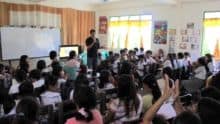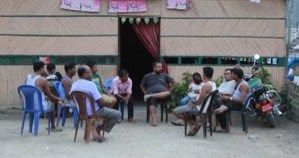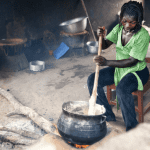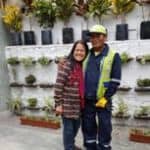Putting Energy to Work: Community and Business Partnerships for Sustainable Local Futures
Editor’s note: This post is part of the NextBillion Series “New Frontiers in Renewable Energy” that explores the dynamic changes reshaping the sector. Learn more about NextBillion’s other 2019 series here.
“I thought solar is good only for charging my battery and save me the trip to the city every time it runs out. I never imagined it can make my children want to go to school or get drinking water!”
In an off-grid community, five hours north of metro Manila, a woman expresses her surprise at the new realization. She has just participated in the first public engagement for collectively designing a community development project at Magalipit village. The project anchors around solar electrification of the local elementary school, which enables audio and video classroom instruction, a digital library and more comfortable classrooms. Beyond this phase 1, the parent-teacher association is now collectively planning on expanding the services made possible by the solar facility, to address larger issues facing the community; e.g. clean drinking water, charging stations for batteries and acquiring new, energy efficient appliances for homes. This planning for services to improve the quality of life here is made possible by the involvement of several actors, who bring a diverse set of specialties and goals to the process.
In contrast stands the solar mini-grid in the village of Harkapur, Nepal. In this facility, a management structure and procedures mandated by an assortment of funding agencies are overwhelming the local committee. In under three years, the technology provider has lost interest in the upkeep of the infrastructure, resulting in a nearly dead battery bank and diesel generators pressed in to make up for the energy deficit. Rising costs, non-payments, nepotism and a general lack of capacity to navigate a complicated landscape are all causing the project to slide to a premature end, resulting in an uncertain energy future for this community. A leading member of the village energy committee said in an interview: “The solar company made their money; the donors got their names on the plaque; they are not interested anymore. So, we are just trying to keep this going for as long as we can and hope for a rescue.”
There are two key differentiators between the two projects. First, the Philippines project features the intentional make-up of a core stakeholder group that involves actors from various domains of the community development spectrum – not just the technology provider(s) and consumers. Secondly, that project’s stakeholders demonstrate a commitment to continuously explore value creation opportunities – not simply electrification – and design systems that complement the vision of a thriving community.
Collaborating for Sustainable Change

An upgraded classroom at Magalipit Elementary. Solar Solutions‘s representative explains how solar works to an enthusiastic group.
These are two cases (among several) analyzed for the applied research project “Implementing Off-Grid Renewable Energy to Create Social Value and Community Development.” The project’s goal is to co-design green energy initiatives that impact individual and collective well-being, i.e. create “energy thriving” for remote and marginalized communities.
We describe energy thriving as the creation of social value from energy solutions. These solutions must then be sustained and evolve with changing needs, such that they are equitable and just – and consider the diversity of the place without causing long-term harm. Together with grassroots practitioners, we ask: “What design practices make energy projects deliver and sustain social value for communities, beyond electrons?” The social value of energy approach – one of the three elements of energy thriving – helps identify economic or monetary benefits, non-monetary benefits and costs, and burdens or potential harms from energy services. We apply this lens when looking at past failures, successes and ways to improve design practices.
This led us to an important design feature of energy projects that are creating positive impacts on the quality of life in disadvantaged communities. Multi-dimensional partnerships, as we are calling them, involve actors with a collection of complementary skills and sectoral specializations required for achieving local development objectives. These diverse actors, collaborating over commonly-held goals yet with unique allocated functions, are better equipped to leverage the possibilities of decentralized energy technology to achieve the goal of energy thriving. More significantly, such partnerships vest in every stakeholder a commitment to perform a specific function, and to learn from and adapt to situations, while not burdening the community with complexity beyond their means.
Magalipit, for example, has created a stakeholder base that includes a solar technology provider (Solar Solutions Inc.), an education-focused charity (Let’s Read), a government agency (Department of Science and Technology) and a microfinance provider (Kasagana-ka). All of them are tied together through the school and the parent-teacher association as the community principal in the mix.
Similar results have been observed with our partner in Nepal, SunBridge Solar Inc. In some of their projects on solar-powered water pumping, like the Small Towns Water Supply and Sanitation Project and irrigation systems used in remote farming communities, the strength of multi-dimensional partnerships emerges in various ways. In all cases, the user groups have felt empowered and unburdened to explore better utilization pathways for the water and solar pumps, given that they could bank upon adequate organizational and technological capacity created by other stakeholders. We took this insight to a new solar micro-grid project in the village of Gurmi in southeast Nepal, forming an organizational structure of shared roles between the technology, service and oversight functions.
Multi-dimensional Solutions

The market committee of Gurmi, Nepal deliberating on the terms and schedule of payments.
It is clear that energy solutions are an important piece among many in the complex puzzle of social development in marginalized communities. But an attempt to create energy access without considering its role and impact on overall challenges to well-being may simply end up as a checked box on a list, without actually moving the needle on any of the SDGs. After all, it is not the ability to turn on a lightbulb that makes a difference in people’s lives – it’s how they use the illumination to create value that improves well-being. Actors at the grassroots level, nonprofits, community-based organizations and small businesses are well-positioned to deploy localized solutions with rapid and meaningful impact to specific challenges.
However, no single entity possesses the silver bullet to solve an intricately connected web of challenges, where gains made in one area can set others back. Multi-dimensional partnerships seem to offer a modality to creating pathways towards thriving communities. This research project, which itself is a research-practitioner partnership, has been able to reflexively evaluate the effectiveness of such structures and their ability to tackle uncertainties in an evolving landscape. It’s high time funders and governments prioritize such initiatives, and encourage them to co-develop localized solutions. They hold a greater promise than the standardized models that fit easily onto PowerPoint slides or look promising in glossy reports, but rarely reflect the on-the-ground reality of marginalization.
Saurabh Biswas is a PhD Candidate at the School of Sustainability, Arizona State University.
Main image: PTA visioning workshop in progress at Magalipit Elementary School, Philippines, with the Let’s Read program coordinator and representatives of Solar Solutions. Photo provided by author.
About the project:
“Implementing Off-Grid Renewable Energy to Create Social Value and Community Development” is a joint initiative by the Grassroots Energy Innovation Lab (Center for Energy and Society, Arizona State University) and the Institute for Technology Assessment and Systems Analysis (Karlsruhe Institute of Technology). Funded by the Global Consortium for Sustainability Outcomes, it is a collaborative applied project where researchers embed with companies and non-profits around the globe — in Nepal, the Philippines, Uganda, and Bolivia — to study energy projects, critically learn from experiences and use evidence-based co-design practices for developing new projects.
- Categories
- Energy



